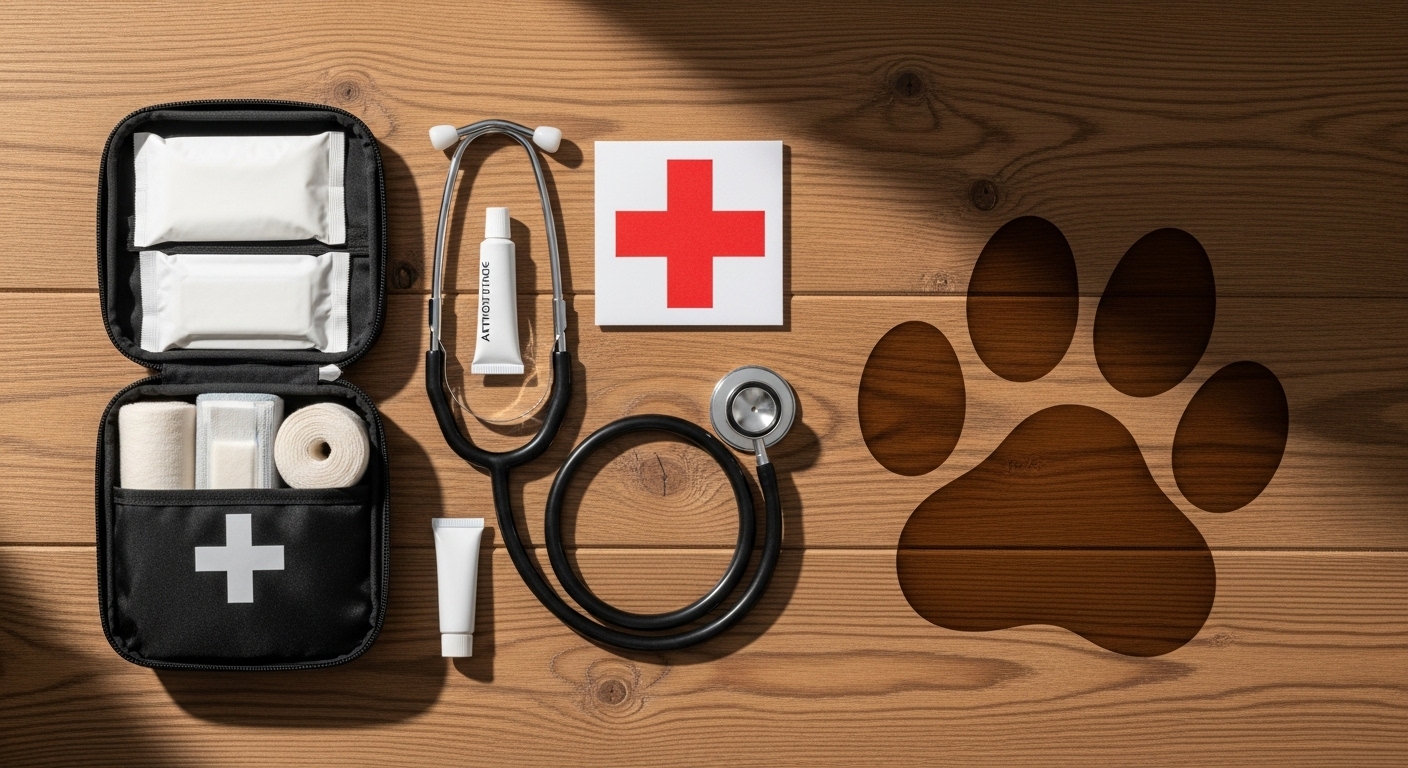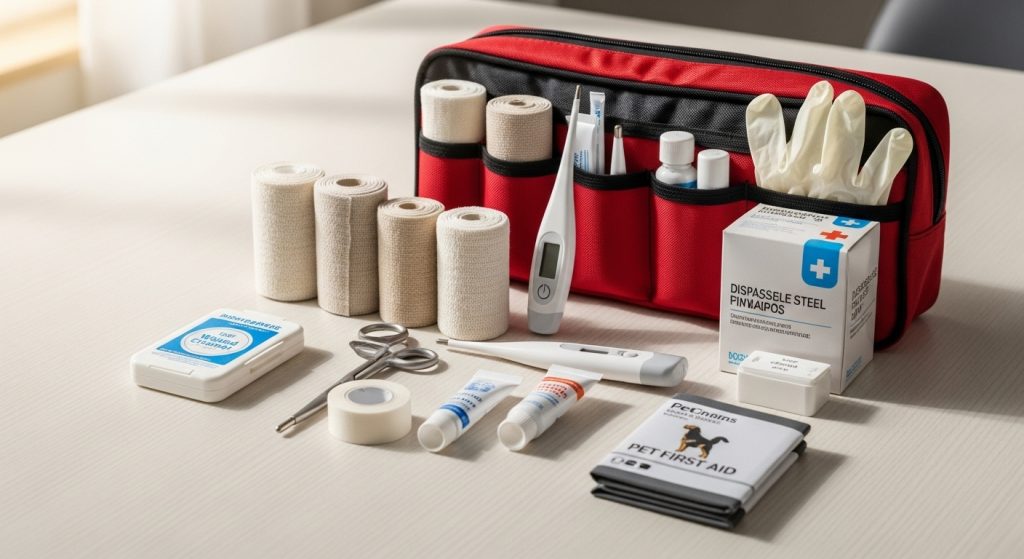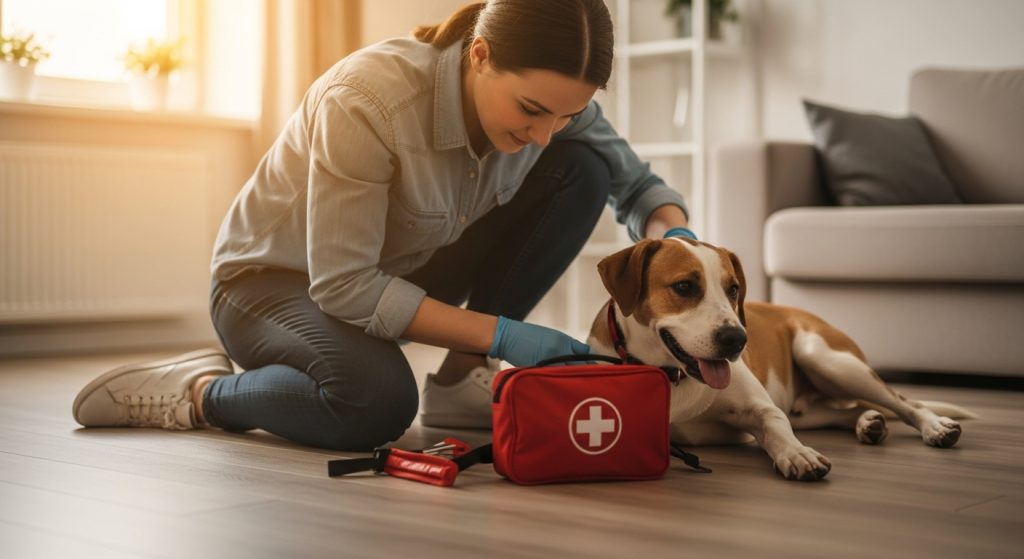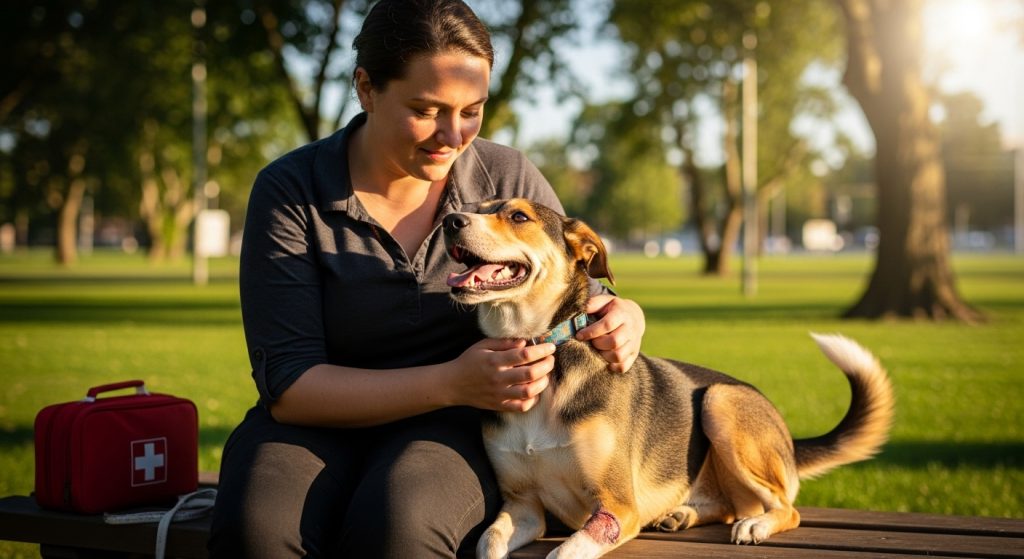Accidents can happen anytime, even to the most careful dog owners. Whether it’s a small cut, insect sting, or something more serious, being prepared with basic dog first aid knowledge can make all the difference in an emergency.
Knowing how to respond quickly and effectively before reaching the vet can save your dog’s life. This guide will teach you everything you need to know — from building a dog first aid kit to handling common injuries safely and calmly.
Let’s dive into the essential dog first aid guide every owner should know.
Building Your Dog First Aid Kit
Why You Need a Dog First Aid Kit
Just like humans, dogs can suffer from accidents, injuries, or sudden illness. Having a dedicated dog first aid kit ensures you’re ready to act fast. A well-organized kit helps you treat minor wounds at home or stabilize your pet until you reach professional care.
What to Include in a Dog First Aid Kit
Here’s a list of must-have items:
Basic Supplies:
-
Sterile gauze pads and non-stick bandages
-
Adhesive tape and self-cling wrap
-
Antiseptic wipes or solution (chlorhexidine or betadine)
-
Tweezers (for removing splinters or ticks)
-
Scissors with blunt ends
-
Digital thermometer
-
Disposable gloves
-
Cotton balls or swabs
-
Saline solution (for rinsing eyes or wounds)
Medications and Treatments:
-
Hydrogen peroxide (3%) – to induce vomiting (only if directed by a vet)
-
Styptic powder – to stop bleeding from minor cuts or broken nails
-
Antihistamine (vet-approved) – for allergic reactions
-
Activated charcoal – for certain toxin ingestion (vet guidance required)
-
Calming spray or treats
Additional Tools:
-
Emergency blanket
-
Muzzle (to prevent biting when in pain)
-
Instant cold pack
-
Flashlight
-
Your vet’s phone number and 24-hour emergency clinic contacts
Storing and Checking Your Kit
Keep your first aid kit in an easily accessible place, and make sure everyone in your household knows where it is. Check supplies every few months — replace expired medications and restock used items.
Common Dog Emergencies and How to Handle Them
1. Cuts, Scrapes, and Bleeding
If your dog has a minor cut:
-
Calm your dog and restrain gently if necessary.
-
Clean the wound with saline or antiseptic solution.
-
Apply gentle pressure with a clean cloth to stop bleeding.
-
Cover with a sterile bandage to prevent dirt and infection.
For deeper wounds or continuous bleeding, wrap with pressure and go to the vet immediately.
2. Burns
If your dog gets burned (from hot surfaces or chemicals):
-
Cool the area with cold running water for 5–10 minutes.
-
Do not apply ointments unless directed by a vet.
-
Cover lightly with a sterile gauze.
-
See a veterinarian as soon as possible.
3. Choking
If your dog is choking:
-
Open the mouth and look for visible objects.
-
Remove it carefully using tweezers if possible.
-
If not breathing, perform Heimlich maneuver for dogs:
-
For small dogs: hold them upside down and gently apply pressure below the ribs.
-
For large dogs: place your arms around their abdomen and thrust inward and upward.
-
-
Once breathing resumes, visit your vet immediately.
4. Heatstroke
Dogs can quickly overheat, especially in hot climates. Signs include:
-
Heavy panting
-
Drooling
-
Weakness or collapse
-
Bright red gums
Move your dog to a cool place, offer small sips of water, and apply cool (not cold) towels to their belly and paws. Never use ice water. Get veterinary help immediately.
5. Poisoning
Common poisons include chocolate, grapes, xylitol, onions, cleaning chemicals, and certain plants.
If ingestion occurs:
-
Call your vet or an emergency poison hotline immediately.
-
Do not induce vomiting unless your vet instructs you to.
-
Save any packaging to show your veterinarian.
6. Seizures
If your dog has a seizure:
-
Stay calm and move objects away to prevent injury.
-
Do not touch the mouth — dogs may bite reflexively.
-
Time the seizure duration.
-
Afterward, keep your dog in a quiet, safe space and contact your vet.
First Aid Skills Every Dog Owner Should Know
1. Checking Vital Signs
Knowing your dog’s normal vitals helps you recognize when something is wrong.
Normal ranges:
-
Temperature: 101–102.5°F (38.3–39.2°C)
-
Heart rate: 60–140 beats per minute (depending on size)
-
Respiratory rate: 10–30 breaths per minute
-
Capillary refill time (gum color): under 2 seconds
Learn how to take your dog’s temperature rectally with a digital thermometer and how to check pulse on the inner thigh (femoral artery).
2. Performing CPR on a Dog
In extreme emergencies, such as cardiac arrest:
-
Lay your dog on their right side.
-
Place your hands over the widest part of the chest.
-
Compress firmly — about 1/3 of chest depth — 100–120 times per minute.
-
After 30 compressions, give 2 rescue breaths by sealing the dog’s muzzle and blowing air into the nostrils.
-
Continue until your dog breathes or help arrives.
3. Handling Broken Bones
If your dog is limping or can’t walk:
-
Do not try to realign the bone.
-
Keep your dog still and carry them gently.
-
Use a blanket or towel as a stretcher.
-
Visit the vet immediately.
4. Preventing Emergencies Before They Happen
Prevention is the best first aid. You can reduce risks by:
-
Keeping toxic foods and substances out of reach.
-
Supervising your dog during play or walks.
-
Using flea/tick preventatives to avoid infections.
-
Scheduling regular vet checkups.
Being a responsible dog owner means being ready for the unexpected. With the right dog first aid knowledge, you can stay calm during emergencies and give your pet the care they deserve.
Always remember — your quick action can save lives, but professional veterinary help is essential after first aid. Keep learning, stay prepared, and your furry friend will thank you with endless love.




